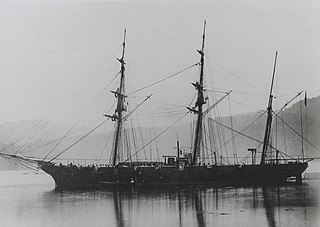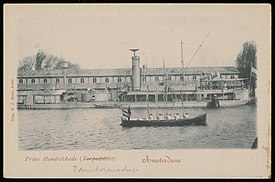
The 68-pounder cannon was an artillery piece designed and used by the British Armed Forces in the mid-19th century. The cannon was a smoothbore muzzle-loading gun manufactured in several weights, the most common being 95 long cwt (4,800 kg), and fired projectiles of 68 lb (31 kg). Colonel William Dundas designed the 112 cwt version in 1841 and it was cast the following year. The most common variant, weighing 95 cwt, dates from 1846. It entered service with the Royal Artillery and the Royal Navy and saw active service with both arms during the Crimean War. Over 2,000 were made and it gained a reputation as the finest smoothbore cannon ever made.

The Atjeh class was a class of unprotected cruisers of the Royal Netherlands Navy. The class comprised Atjeh, Tromp, Koningin Emma der Nederlanden, De Ruyter, Van Speyk and Johan Willem Friso.
The Adder-class monitors were a group of six ironclad monitors built for the Royal Netherlands Navy in the 1870s.

The Heiligerlee-class monitors were a group of five ironclad monitors built for the Royal Netherlands Navy in the late 1860s.

The Djambi class was a class of steam corvettes of the Royal Netherlands Navy. The class comprised Djambi, Zoutman, Willem, Leeuwarden, Metalen Kruis and Curaçao. Later two ships of a supposedly 'slightly revised' type were built, the Zilveren Kruis-class corvettes.

The Watergeus class was a class of screw sloop-of-war of the Royal Netherlands Navy. The class comprised the 'Watergeus' and the Marnix. A third ship that had been planned was cancelled.

The Groningen class was a class of steam corvettes of the Royal Netherlands Navy. The class comprised Groningen, Citadel van Antwerpen and Vice-Admiraal Koopman

The Vesuvius class was a class of steam screw sloops of the Royal Netherlands Navy. The class comprised Vesuvius, Cornelis Dirks, Reinier Claessen, Het Loo, Reteh and Prinses Maria.

The Samarang class was a class of steam screw gunvessels of the Royal Netherlands Navy. The class originally comprised Samarang, Batavia and Makassar, but was later extended.

The Ever class was a class of 14 flat-iron gunboats of the Royal Netherlands Navy.

Onrust Dock of 5,000 tons, was a floating dry dock which served in the Dutch East Indies from 1881 till 1924.

The Wodan class was a class of 16 flat-iron gunboats of the Royal Netherlands Navy.

The RML 9-inch Armstrong Gun was a rifled muzzle loading gun, used in substantial numbers by the Dutch navy, the Spanish Navy, and other navies. It should not be confused with the RML 9-inch 12-ton gun, used in the British Royal Navy.

HNLMS Matador was a monitor built in the late 1870s.

The RML 16 cm No. 3, or Getrokken kanon van 16 cm No. 3 was a rifled muzzle loading gun. It was a Dutch attempt to cheaply provide rifled ordnance to its navy.

The RML 16 cm No. 1, or Getrokken kanon van 16 cm No. 1 was a rifled muzzle loading gun. It was the first Dutch rifled gun which had been designed as such.

The RML 7-inch Armstrong Gun was a rifled muzzle loading gun. It was an export version of the British Royal Navy's RML 7-inch gun. The RML 7-inch Armstrong Gun was produced by William Armstrong's Elswick Ordnance Company.

The 12 cm K.A. was a Dutch fortress, siege and naval rifled bronze breechloading gun. In the Dutch army it was called Kanon Brons getrokken van 12 cm K.A.. In the Dutch navy: Kanon van 12 cm A No. 2. It was produced in substantial numbers in the Netherlands. There were also steel and steel bronze versions.

The 8.4 cm Feldgeschütz Ord 1871 is a 19th-century Swiss and Dutch field gun. The Dutch version was known as Kanon van 8 cm achterlaad. The Swiss version was replaced by the 8.4 cm Feldgeschütz Ord 1879. The Dutch version was replaced by the 8 cm staal.

The 17 cm RK L/25 was a gun from a family of German naval artillery guns developed in the 1870s. Before World War I, the gun was used on warships of the Imperial German Navy, the Royal Netherlands Navy, and other navies.



















